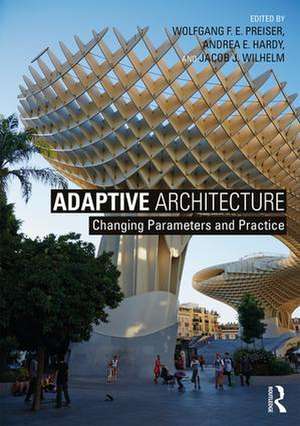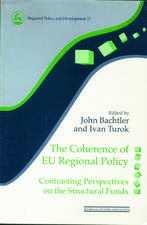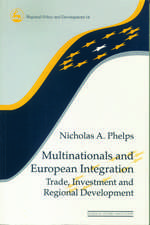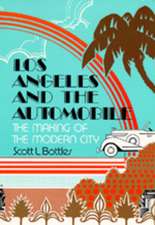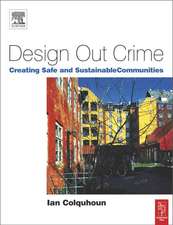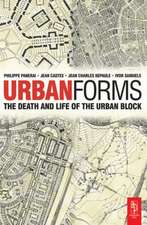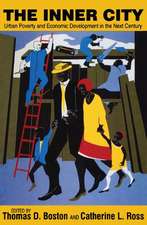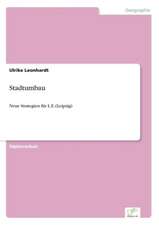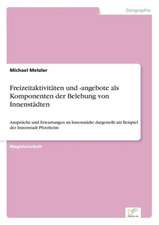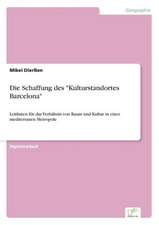Adaptive Architecture: Changing Parameters and Practice
Editat de Wolfgang F. E. Preiser, Andrea E. Hardy, Jacob J. Wilhelmen Limba Engleză Paperback – 29 aug 2017
Preț: 492.26 lei
Nou
Puncte Express: 738
Preț estimativ în valută:
94.21€ • 97.52$ • 79.63£
94.21€ • 97.52$ • 79.63£
Carte tipărită la comandă
Livrare economică 05-19 martie
Preluare comenzi: 021 569.72.76
Specificații
ISBN-13: 9781138647275
ISBN-10: 1138647276
Pagini: 302
Ilustrații: 66 Line drawings, black and white; 64 Halftones, black and white; 5 Tables, black and white; 130 Illustrations, black and white
Dimensiuni: 174 x 246 x 18 mm
Greutate: 0.68 kg
Ediția:1
Editura: Taylor & Francis
Colecția Routledge
Locul publicării:Oxford, United Kingdom
ISBN-10: 1138647276
Pagini: 302
Ilustrații: 66 Line drawings, black and white; 64 Halftones, black and white; 5 Tables, black and white; 130 Illustrations, black and white
Dimensiuni: 174 x 246 x 18 mm
Greutate: 0.68 kg
Ediția:1
Editura: Taylor & Francis
Colecția Routledge
Locul publicării:Oxford, United Kingdom
Public țintă
Postgraduate, Professional, and UndergraduateCuprins
Foreword Robert Shibley Part 1: Introduction Wolfgang F.E. Preiser, Thomas Fisher and, Andrea E. Hardy Part 2: Concepts and Processes for Future Flexibility 1. Challenges of large-scale housing in the developing world Allison Lenell Magley 2. Predesign planning for flexibility Robert G. Hershberger 3. Multi-perfomance spaces Ihab M. K. Elzeyadi 4. Mixed-use development using air rights above the JR train station at Nagoya, Japan Gen Taniguchi 5. Prospects for adaptive, inclusive design Korydon H. Smith and Beth Tauke Reflections on Part 2 Michael J. Crosbie Part 3: Rooms/Settings Scale 6. The measurement and efficiency of adaptive design strategies William Fawcett 7. Finding the balance Jeffrey L. Morgan 8. Beyond the cellular office Martin Hodulak 9. Adaptive architecture of the London Science Museum Kristin Hibbs 10. Post-occupancy evaluation of a multi-tasking environment Lindsey L. Fay 11.A construct of generosity in Navajo culture Jaclyn Roessel Reflections on Part 3 Michael J. Crosbie Part 4: Building Scale 12. Keren or center for blind children with multiple disabilities in Israel Wolfgang F.E. Preiser and Jacob J. Wilhelm 13. Omgivning Karin Liljegren and Kelly Kish 14. Strategies for planning, designing and operating adaptable facilities John P. Petronis, Faye Whittemore, and Andy L. Aguilar 15. Native meets high-tech Zane Jones 16. Building with boxes Mia L. C. Anfield Reflections on Part 4 Michael J. Crosbie Part 5: Urban Scale 17. Reappropriation of city infrastructure Andrea E. Hardy 18. Concourse to campus Una Rath and Martin Hodulak 19. An adaptive evolution from Prussian artillery barracks to intelligent campus buildings Ulrich Schramm 20. A case study on the design of the Scottish crime campus Gordon Murray 21. Multi-tasking architectural computer programs Akikazu Kato and Shiho Mori Reflections on Part 5 Michael J. Crosbie Part 6: Epilogue 22. The International Space Station David Fitts, Jennifer L. Rochlis, Mihriban Whitmore, and Alexandra Whitmire Appendix Index
Notă biografică
Wolfgang F.E. Preiser holds a Ph.D. in Man-Environment Relations from Penn State, and several architecture degrees from Virginia Tech, Karlsruhe Tech (Germany) and Vienna Tech (Austria). He has over 40 years of experience in teaching, research and consulting in the evaluation and programming of environments, including health care facilities, public housing, public libraries, cross-cultural and universal design, as well as design research in general.
He has published 20 books and over 130 chapters, monographs, and articles. Most recent books include:Architecture Beyond Criticism: Expert Judgment and Performance Evaluation(Routledge, 2015);Enhancing Building Performance (Wiley, 2012); Universal Design Handbook (McGraw-Hill, 2010);Designing for Designers: Lessons Learned From Schools of Architecture (Fairchild, 2007). Preiser has lectured worldwide at 69 venues and conferences in the United States and Canada, as well as 86 overseas. He has served on national committees with the American Institute of Architects, the Building Research Board of the National Academy of Sciences, and the National Institute for Disability Rehabilitation Research.
Preiser has received many awards, including: 2 Progressive Architecture Awards; 2 Professional Fellowships from the National Endowment for the Arts; The Career Award from the Environmental Design Research Association (EDRA), 2 EDRA Achievement Awards, as well as other awards while at the University of Cincinnati.
Andrea E. Hardy, Creo Architects, holds a Master’s degree in Architecture from Arizona State University (2012), and a Bachelor of Science in Architectural Engineering Technology from Wentworth Institute of Technology (2007).
She has been working in architecture offices for the past twelve years both during and between obtaining her degrees. After working professionally in Boston and Phoenix, and studying public architecture through Arizona State University in Buenos Aires, Argentina, Hardy is currently an Associate and Registered Architect working at Creo Architects in Phoenix, Arizona.
While at Arizona State University, Hardy was a member of the American Institute of Architecture Students, served one term as Secretary for the American Institute of Architecture Students, was a teaching assistant for a design studio and history class, received multiple scholarships, and participated in non-academic activities such as working on multiple design competitions, workshops, and volunteer work.
Recently, Hardy was published as co-editor and co-author in Architecture Beyond Criticism: Expert Judgment and Performance Evaluation (2015), contributed to updating Improving Building Performance NCARB Monograph series (2016), and is currently working on, as an editor, the forthcoming second edition to Building Performance Evaluation (exp 2017).
Jacob J. Wilhelm holds a Bachelor of Science in Design in Architectural Studies from Arizona State University (2016). He is the recipient of many awards and grants based on his work in design and publication. While at Arizona State University, Wilhelm held various leadership roles, serving with Alpha Rho Chi as President and with the American Institute of Architecture Students, Students for the New Urbanism, and the Student Planning Association. Both as an individual and collaborating with students in the fields of Architecture, Industrial Design, Urban Planning, and more, Wilhelm has been awarded in multiple local design competitions as sponsored by Arizona Residential Architects, the Scottsdale Museum of Art, and Arizona State University. He is committed to expanding architectural discourse through interdisciplinary study, research, and theory, and his current focus is in architectural practice and publication.
He has published 20 books and over 130 chapters, monographs, and articles. Most recent books include:Architecture Beyond Criticism: Expert Judgment and Performance Evaluation(Routledge, 2015);Enhancing Building Performance (Wiley, 2012); Universal Design Handbook (McGraw-Hill, 2010);Designing for Designers: Lessons Learned From Schools of Architecture (Fairchild, 2007). Preiser has lectured worldwide at 69 venues and conferences in the United States and Canada, as well as 86 overseas. He has served on national committees with the American Institute of Architects, the Building Research Board of the National Academy of Sciences, and the National Institute for Disability Rehabilitation Research.
Preiser has received many awards, including: 2 Progressive Architecture Awards; 2 Professional Fellowships from the National Endowment for the Arts; The Career Award from the Environmental Design Research Association (EDRA), 2 EDRA Achievement Awards, as well as other awards while at the University of Cincinnati.
Andrea E. Hardy, Creo Architects, holds a Master’s degree in Architecture from Arizona State University (2012), and a Bachelor of Science in Architectural Engineering Technology from Wentworth Institute of Technology (2007).
She has been working in architecture offices for the past twelve years both during and between obtaining her degrees. After working professionally in Boston and Phoenix, and studying public architecture through Arizona State University in Buenos Aires, Argentina, Hardy is currently an Associate and Registered Architect working at Creo Architects in Phoenix, Arizona.
While at Arizona State University, Hardy was a member of the American Institute of Architecture Students, served one term as Secretary for the American Institute of Architecture Students, was a teaching assistant for a design studio and history class, received multiple scholarships, and participated in non-academic activities such as working on multiple design competitions, workshops, and volunteer work.
Recently, Hardy was published as co-editor and co-author in Architecture Beyond Criticism: Expert Judgment and Performance Evaluation (2015), contributed to updating Improving Building Performance NCARB Monograph series (2016), and is currently working on, as an editor, the forthcoming second edition to Building Performance Evaluation (exp 2017).
Jacob J. Wilhelm holds a Bachelor of Science in Design in Architectural Studies from Arizona State University (2016). He is the recipient of many awards and grants based on his work in design and publication. While at Arizona State University, Wilhelm held various leadership roles, serving with Alpha Rho Chi as President and with the American Institute of Architecture Students, Students for the New Urbanism, and the Student Planning Association. Both as an individual and collaborating with students in the fields of Architecture, Industrial Design, Urban Planning, and more, Wilhelm has been awarded in multiple local design competitions as sponsored by Arizona Residential Architects, the Scottsdale Museum of Art, and Arizona State University. He is committed to expanding architectural discourse through interdisciplinary study, research, and theory, and his current focus is in architectural practice and publication.
Recenzii
‘Adaptive Architecture is a rigorous and thoughtful guide, full of important precedent studies, for architects and building professionals navigating an increasingly complex, fluid, and interdependent world of sociocultural, economic and climatic design challenges.’ - Philip Horton, The Design School, Arizona State University, USA
Descriere
This book is aimed at academics, researchers, libraries and high level undergraduate and postgraduate students, on courses such as: professional practice, universal design, research in design, architectural design data.
